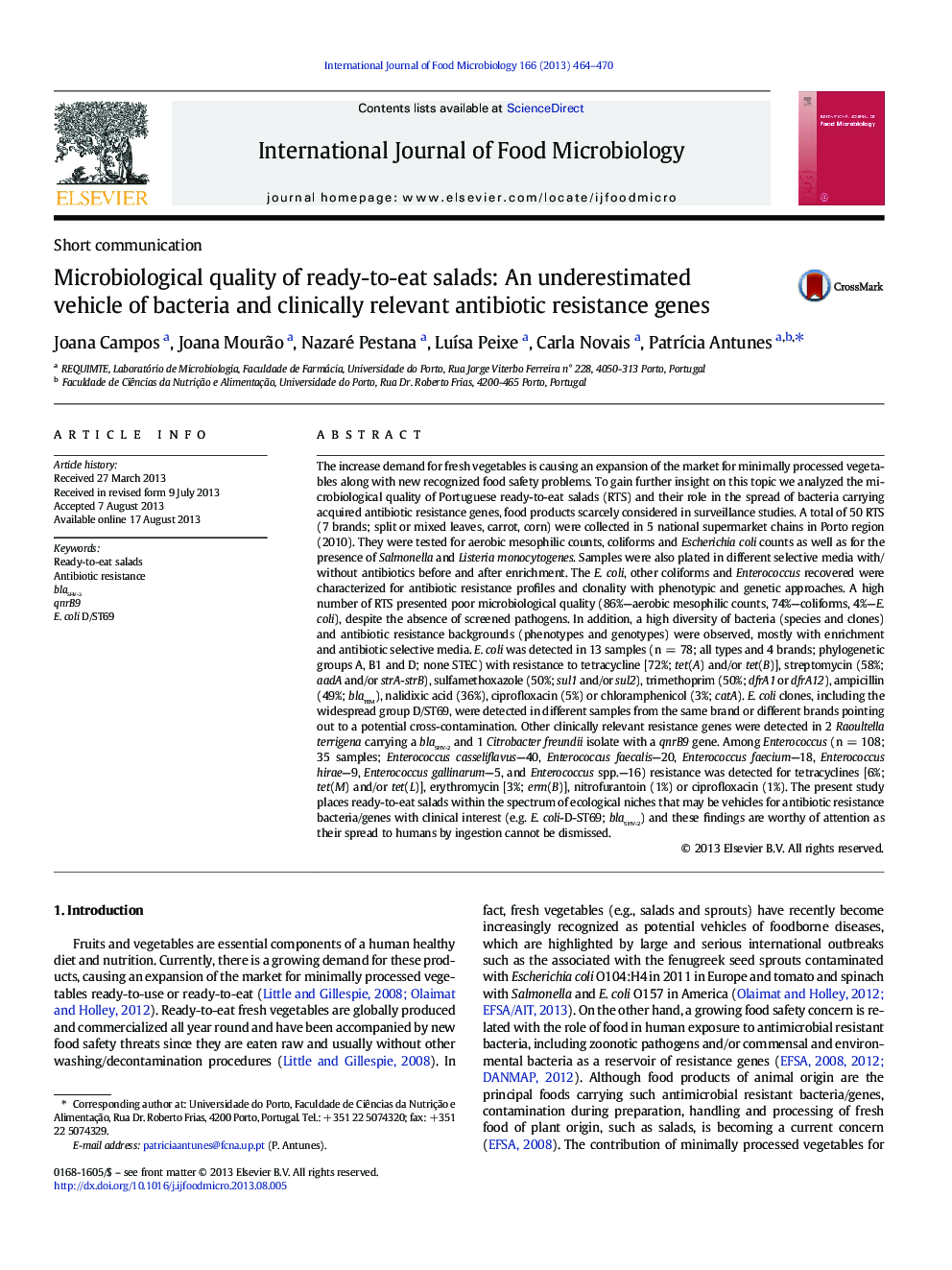| کد مقاله | کد نشریه | سال انتشار | مقاله انگلیسی | نسخه تمام متن |
|---|---|---|---|---|
| 6290260 | 1616617 | 2013 | 7 صفحه PDF | دانلود رایگان |
عنوان انگلیسی مقاله ISI
Microbiological quality of ready-to-eat salads: An underestimated vehicle of bacteria and clinically relevant antibiotic resistance genes
ترجمه فارسی عنوان
کیفیت میکروبیولوژیکی سالاد آماده به غذا: یک وسیله نادری از باکتری ها و ژن های مقاوم به آنتی بیوتیکی بالینی
دانلود مقاله + سفارش ترجمه
دانلود مقاله ISI انگلیسی
رایگان برای ایرانیان
موضوعات مرتبط
علوم زیستی و بیوفناوری
علوم کشاورزی و بیولوژیک
دانش تغذیه
چکیده انگلیسی
The increase demand for fresh vegetables is causing an expansion of the market for minimally processed vegetables along with new recognized food safety problems. To gain further insight on this topic we analyzed the microbiological quality of Portuguese ready-to-eat salads (RTS) and their role in the spread of bacteria carrying acquired antibiotic resistance genes, food products scarcely considered in surveillance studies. A total of 50 RTS (7 brands; split or mixed leaves, carrot, corn) were collected in 5 national supermarket chains in Porto region (2010). They were tested for aerobic mesophilic counts, coliforms and Escherichia coli counts as well as for the presence of Salmonella and Listeria monocytogenes. Samples were also plated in different selective media with/without antibiotics before and after enrichment. The E. coli, other coliforms and Enterococcus recovered were characterized for antibiotic resistance profiles and clonality with phenotypic and genetic approaches. A high number of RTS presented poor microbiological quality (86%-aerobic mesophilic counts, 74%-coliforms, 4%-E. coli), despite the absence of screened pathogens. In addition, a high diversity of bacteria (species and clones) and antibiotic resistance backgrounds (phenotypes and genotypes) were observed, mostly with enrichment and antibiotic selective media. E. coli was detected in 13 samples (n = 78; all types and 4 brands; phylogenetic groups A, B1 and D; none STEC) with resistance to tetracycline [72%; tet(A) and/or tet(B)], streptomycin (58%; aadA and/or strA-strB), sulfamethoxazole (50%; sul1 and/or sul2), trimethoprim (50%; dfrA1 or dfrA12), ampicillin (49%; blaTEM), nalidixic acid (36%), ciprofloxacin (5%) or chloramphenicol (3%; catA). E. coli clones, including the widespread group D/ST69, were detected in different samples from the same brand or different brands pointing out to a potential cross-contamination. Other clinically relevant resistance genes were detected in 2 Raoultella terrigena carrying a blaSHV-2 and 1 Citrobacter freundii isolate with a qnrB9 gene. Among Enterococcus (n = 108; 35 samples; Enterococcus casseliflavus-40, Enterococcus faecalis-20, Enterococcus faecium-18, Enterococcus hirae-9, Enterococcus gallinarum-5, and Enterococcus spp.-16) resistance was detected for tetracyclines [6%; tet(M) and/or tet(L)], erythromycin [3%; erm(B)], nitrofurantoin (1%) or ciprofloxacin (1%). The present study places ready-to-eat salads within the spectrum of ecological niches that may be vehicles for antibiotic resistance bacteria/genes with clinical interest (e.g. E. coli-D-ST69; blaSHV-2) and these findings are worthy of attention as their spread to humans by ingestion cannot be dismissed.
ناشر
Database: Elsevier - ScienceDirect (ساینس دایرکت)
Journal: International Journal of Food Microbiology - Volume 166, Issue 3, 16 September 2013, Pages 464-470
Journal: International Journal of Food Microbiology - Volume 166, Issue 3, 16 September 2013, Pages 464-470
نویسندگان
Joana Campos, Joana Mourão, Nazaré Pestana, LuÃsa Peixe, Carla Novais, PatrÃcia Antunes,
